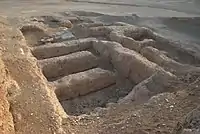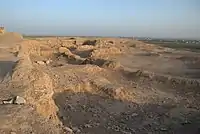Tuttul
Tuttul (Akkadian: tu-ut-tu-ulki,[1] Ugaritic: 𐎚𐎚𐎍 – TTL[2]) was a Bronze Age Amorite city.
 | |
 Shown within Syria  Tuttul (Near East) | |
| Alternative name | Tuttul |
|---|---|
| Location | Al-Raqqah Governorate, Syria |
| Region | Upper Mesopotamia |
| Coordinates | 35°57′27″N 39°2′51″E |
| Type | tell, archaeological site, village |
| Mari |
|---|
 |
| Kings |
| Archaeology |
Tuttul is identified with the archaeological site of Tell Bi'a in Raqqa Governorate, northern Syria. Tell Bi'a is located near the modern city of Raqqa and the confluence of the rivers Balikh and Euphrates.[3][4]
History
During the Middle Bronze Age (c. 2000–1600 BCE), Tuttul was a sacred city to the god Dagan, who was a supreme god in the region of Mari, Terqa and Tuttul,[5] and worshipped across the Ancient Near East. However, the settlement at Tell Bi'a had been occupied since the mid-3rd millennium BCE.[6][7] This town has sometimes also been called the "Northern Tuttul" with reference to an implied "Southern Tuttul", which was possibly located on the Iraqi Euphrates between the ancient cities of Mari and Babylon. However, this is a debated issue.[8] The identification of the so-called "Southern Tuttul" with modern Hit is uncertain, as Hit is referenced to several times in the Mari archives via its modern name.[9]
 Raqqa and Tell Bias
Raqqa and Tell Bias Tuttul
Tuttul Tuttul tombs
Tuttul tombs Tuttul
Tuttul
References
- Dossin, Georges (1940). "Inscriptions de fondation provenant de Mari". Syria. 21 (2): 166. doi:10.3406/syria.1940.4187.
- KTU2 1.100; see צבי ושפרה רין, עלילות האלים, ענבל, 1996, עמ' 693 (in Hebrew); George, Andrew; Krebernik, Manfred (2022). "Two Remarkable Vocabularies: Amorite-Akkadian Bilinguals!". Revue d'assyriologie et d'archéologie orientale. 116 (1): 118. doi:10.3917/assy.116.0113. ISSN 0373-6032.
- Heimpel, Wolfgang., "On the Recently Published Old Babylonian Texts from Tuttul", Orientalia, vol. 72, no. 3, pp. 307–26, 2003
- Dossin, Georges, "LE SITE DE TUTTUL-SUR-BALÎḪ", Revue d’Assyriologie et d’archéologie Orientale, vol. 68, no. 1, pp. 25–34, 1974
- George, Andrew; Krebernik, Manfred (2022). "Two Remarkable Vocabularies: Amorite-Akkadian Bilinguals!". Revue d'assyriologie et d'archéologie orientale. 116 (1): 118. doi:10.3917/assy.116.0113. ISSN 0373-6032.
- Ildiko Bosze, "Analysis of the Early Bronze Age Graves in Tell Bi'a (Syria)", BAR International Series, 2009 ISBN 978-1407305295
- Akkermans, Peter M. M. G.; Schwartz, Glenn M. (2003), The archaeology of Syria. From complex hunter-gatherers to early urban societies (ca. 16,000–300 BC), Cambridge: Cambridge University Press, pp. 255–256, ISBN 0-521-79666-0
- Astour, M.C. (2002), "A reconstruction of the history of Ebla (Part 2)", in Gordon, C.H.; Rendsburg, G.A. (eds.), Eblaitica: Essays on the Ebla archives and Eblaite language, Winona Lake: Eisenbrauns, pp. 57–195, ISBN 978-1-57506-060-6
- Malamat, Abraham (1998), Mari and the Bible, Leiden: Brill, p. 92, ISBN 978-90-04-10863-9